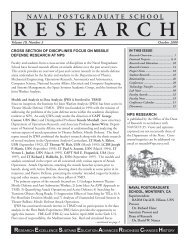Spectral Unmixing Applied to Desert Soils for the - Naval ...
Spectral Unmixing Applied to Desert Soils for the - Naval ...
Spectral Unmixing Applied to Desert Soils for the - Naval ...
Create successful ePaper yourself
Turn your PDF publications into a flip-book with our unique Google optimized e-Paper software.
Figure 33. This figure shows <strong>the</strong> adjacent <strong>to</strong> tread endmember results with MF scores<br />
of 5–52% using <strong>the</strong> f110512t01p00r08 <strong>for</strong> a repeatability test. Areas of<br />
highest target material concentrations are associated with regions of<br />
unconsolidated material on steep sides of lithified rock structures. Areas<br />
surrounding <strong>the</strong> rock structures are thought <strong>to</strong> have less target material<br />
because <strong>the</strong>y are flat and may be more settled.<br />
3. Biological Soil Crust Endmembers<br />
BSCs yielded results with similar value ranges <strong>to</strong> o<strong>the</strong>r endmembers of 9–11% in<br />
most cases. Some areas yielded smaller values closer <strong>to</strong> 5–7%. To test BSCs, imagery-<br />
derived endmembers, following <strong>the</strong> parameters of Weber et al (2008), had <strong>to</strong> be<br />
identified. This meant first identifying imagery derived endmembers as BSCs using <strong>the</strong><br />
absorption feature seen around 650 nm in continuum removed spectra not present in bare<br />
soils (Weber et al., 2008). Most of <strong>the</strong> endmembers corresponded <strong>to</strong> vegetation and soils,<br />
66
















